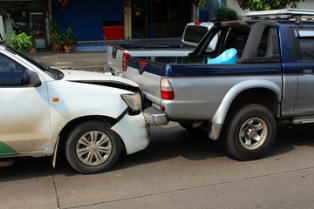A rear-end collision happens when a car crashes into the back of the car in front of it. This is the most common type of vehicle accident, and it generally happens when the driver of the vehicle in back follows the vehicle in front too closely. 
Causes of Rear-end Collisions
There are a variety of ways a rear-end collision can occur, including:
- Tailgating. When a driver follows too closely to the vehicle in front of him, he may not be able to react quickly enough should the vehicle ahead of him stop suddenly.
- Distracted driving. Texting, eating, and looking away from the road are common causes of driver distraction.
- Driving under the influence. Driving under the influence of drugs or alcohol makes it more difficult to judge stopping distances.
- Driving with faulty brake lights. If the vehicle in front has brake lights that aren’t functional, the driver of the vehicle following it may be unaware of the driver’s intention to stop.
- Driving while fatigued. Falling asleep at the wheel is a common cause of rear-end accidents and is especially prevalent on long highway trips.
Common Rear-end Accident Injuries
Victims of rear-end collision injuries frequently fail to realize the extent of their injuries immediately following an accident. The adrenaline released during a collision can temporarily mask injury symptoms. Occupants of the vehicle in front typically suffer the most severe injuries from a sudden impact. The most common rear-end collision injuries include:
- Whiplash. When the neck, shoulders, and spine are subjected to violent forces in a vehicle accident, the resulting injury is referred to as whiplash.
- Head and face injuries. Airbag deployment can sometimes lead to injuries to the head and face, including burning of your facial area and scalp.
- Seat belt injuries. A sudden rear-end impact can thrust your torso forward, causing bruises and lacerations as your seat belt holds you in place.
- Ankle and knee damage. Flexing your legs as you brace for an impact can lead to ankle and knee injuries.
- Neck and back injuries. The force of impact in a vehicle accident can put tremendous pressure on the spine, resulting in spinal compression and herniated discs. These injuries can cause chronic pain, possibly requiring surgery and extensive physical therapy.
Fault in Rear-end Collisions
Rear-end collisions are generally considered the fault of the driver in back who strikes the vehicle in front, although this isn’t always the case. Since motorists sometimes stop suddenly due to heavy traffic or road hazards, every driver is expected to follow the car in front at a safe distance. Therefore, any driver who rear-ends another vehicle is likely to be considered at least partly at fault. It is possible, however, for the driver of the vehicle in front to share responsibility for the accident. Should he stop suddenly without reasonable cause, fail to yield to traffic, or if his brake lights are faulty, he could be considered partially responsible for the accident.
Pure Contributory Negligence
Virginia is one of only a few states that uses the pure contributory negligence rule. This means, if you are involved in a collision in which you are considered to be even one percent at fault, state law prevents you from recovering any damages whatsoever. If, for example, your vehicle is struck by a vehicle from behind while you’re sitting at a red light, but you have a malfunctioning brake light, you may be considered partially responsible for the accident. In this case, you would be barred from receiving any compensation.
You Need an Attorney
If you’ve been injured in a rear-end collision, you need professional representation by an experienced attorney. Due to Virginia’s pure contributory negligence rule, if you’re found to be even marginally at fault in an accident, your ability to recover may be in jeopardy. You need an attorney with the experience to show that you’re not liable. Contact the vehicle accident attorneys of Kearney, Freeman, Fogarty & Joshi, PLLC, by using the form on this page.
|
Related links: |

